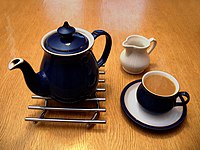తేనీరు: కూర్పుల మధ్య తేడాలు
చి యంత్రము కలుపుతున్నది: mr:चहा |
WikiDreamer Bot (చర్చ | రచనలు) చి యంత్రము కలుపుతున్నది: sah:Чэй |
||
| పంక్తి 81: | పంక్తి 81: | ||
[[ru:Чай]] |
[[ru:Чай]] |
||
[[rw:Icyayi]] |
[[rw:Icyayi]] |
||
[[sah:Чэй]] |
|||
[[scn:Tè]] |
[[scn:Tè]] |
||
[[sco:Tea]] |
[[sco:Tea]] |
||
16:09, 5 ఆగస్టు 2008 నాటి కూర్పు
తేనీరు (Tea) ఒక పానీయం. తేయాకు ను నీటిలో మరిగించి వచ్చిన డికాక్షన్ ను తేనీరు అంటారు. దీనిలో పంచదార, పాలు కలుపుకొని త్రాగుతారు.
రకాలు
పాలు తేనీరు

The addition of milk to tea was first mentioned in 1680 by the epistolist Madame de Sévigné.[1] Many teas are traditionally drunk with milk. These include Indian chai, and British tea blends. These teas tend to be very hearty varieties which can be tasted through the milk, such as Assams, or the East Friesian blend. Milk is thought to neutralise remaining tannins[2] and reduce acidity.[ఆధారం చూపాలి]
The order in which to make a cup of tea is a much-debated area. Some say that it is preferable to add the milk before the tea, as the high temperature of freshly brewed tea can denature the proteins found in fresh milk, similar to the change in taste of UHT milk, resulting in an inferior tasting beverage[3]. Others insist that it is better to add the milk after brewing the tea, as most teas need to be brewed as close to boiling as possible. The addition of milk chills the beverage during the crucial brewing phase, meaning that the delicate flavour of a good tea cannot be fully appreciated. By adding the milk afterwards, it is easier to dissolve sugar in the tea and also to ensure that the desired amount of milk is added, as the colour of the tea can be observed.
In Britain and some Commonwealth countries, the order in which the milk and the tea enter the cup is often considered an indicator of social class. Persons of working class background are supposedly more likely to add the milk first and pour the tea in afterwards, whereas persons of middle and upper class backgrounds are more likely to pour the tea in first and then add milk. This is said to be a continuing practice from a time when porcelain (the only ceramic which could withstand boiling water) was only within the purchasing range of the rich - the less wealthy had access only to poor quality earthenware, which would crack unless milk was added first in order to lower the temperature of the tea as it was poured in.[ఆధారం చూపాలి]
A recent medical study found that many healthful effects of tea are lost through the addition of milk.
మూస:Link FA మూస:Link FA మూస:Link FA
- ↑ "The History of Tea". Stash Tea. 2006. Retrieved 2006-11-07.
- ↑ "Some tea and wine may cause cancer - tannin, found in tea and red wine, linked to esophageal cancer" Nutrition Health Review, Fall, 1990
- ↑ "How to make a perfect cuppa". BBC News. 2003-06-25. Retrieved 2006-07-28.
{{cite web}}: Check date values in:|date=(help)